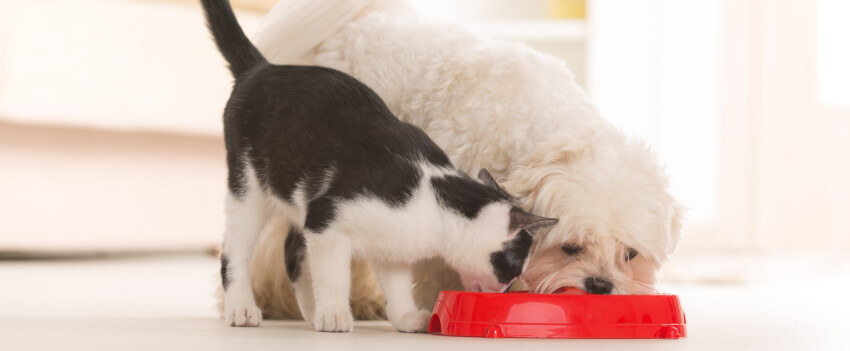The Facts About Grain Diets
This article is written by Pet Circle Animal Nutritionist,
Much like the raw food diet movement, the grain free movement has been very topical and almost a taboo subject in companion animal nutrition. The notion of grain free almost seemed like an overnight sensation back in 2012 when well known commercial pet food companies started having them sitting left, right and centre in pet shop shelves.
It happened to coincide right at the time when paleo and gluten free diets became popularised amongst humans. Whether conscious or not, this hype around 'grain free' caught on very quickly with pet owners. There appeared to be a sudden interest and movement in imposing human fads on our dependent animal's.
Whilst most pet owners will try to go above and beyond in feeding their animals the best that money can buy, as well taking the time in trying to educate themselves in their animal's nutrition, there is an overwhelming amount of information out in the public domain on pet nutrition that can cause a great deal of confusion. This confusion leads some to pick a side, while others give up altogether and just go with whatever is the easiest.
Contents:
The Benefits of Grains

Unlike humans or even wild animals, access to varied feed supplies is limited for our pets. Being a housebound pet somewhat diminishes their natural instincts in knowing what nutrients their body needs, creating a stronger likelihood for developing a taste for the stronger flavours of low nutrient foods much like us humans and takeaway. Therefore, our pet's are solely dependent on us to meet their nutritional needs.
In meeting those needs, we really need to get back to basics of what our pet's need nutritionally. With that said, one of the most nutritionally rich and useful nutrients available to our pets are grains. Whole grains are a very cost-effective and environmentally sustainable way in providing a large proportion of our pet's diet. Not only do grains provide carbohydrates, they provide an array of vitamins and minerals, as well as being an economical source of protein. When grains are combined, the biological effectiveness of it's protein is considerably enhanced bringing a completeness and balance in amino acids.
- Cost effective
- Environmentally sustainable
- Provide essential vitamins and minerals
- Ethical source of protein
- Complete and balanced amino acids
Benefits of Grains:
On a dry weight basis, carbohydrates when prepared correctly can provide more than half of the diet for dogs and cats.
With that said, due to the short intestinal tracts of cats and dogs, pre-digestion methods such as cooking of grains is necessary for starch digestibility. Uncooked forms of grains can cause an adverse effect on intestinal metabolism. Prepared correctly, grains are completely utilised by the body. If we are to reference the wild carnivorous ancestors of our pet's, much of their grain intake was from the stomach contents of their prey which was already pre-digested and thus valuable for them.
Good Grains To Use For Our Pets

There are numerous grains that can be given to our pet's, however it is best to keep things simple both in time and money. The grains listed below are perhaps the most economical, quick-cooking, highly nutritious and well accepted by both cats and dogs:
Oatmeal
- High in protein
- Rich in minerals and vitamins
- Good source of fibre
Cornmeal
- Good source of iron
- Rich in minerals
Millet
- Rich in iron
Bulgur
- High in protein
- High levels of minerals
- Low fat and high fibre
Recommended Grain Diets for Dogs:
What about Grains and Cats?

To add to the controversy, the notion of cats and grains is fiercely debated. There is a notion of cats being unable to digest dietary carbohydrates stemming from their lack of glucokinase (an enzyme used to phosphorylate glucose inside cells) and the lack of salivary amylase which is due to the lower enzymatic activity of carbohydrate digestion compared with dogs.
Like all mammals, cats derive energy from the oxidation of fat, protein and carbohydrate. The diet of a particular cat, determines where the fuel for energy is derived from. Whilst cats do not have a need for dietary carbohydrates and have evolved on low-carb diets, their digestive systems and metabolism can easily adjust to higher carbohydrate intakes.
Recommended Grain Diets for Cats:
Food For Thought

As pet owners it is important to be mindful of the responsibility we have in feeding our pet's. We need to avoid imposing our dietary requirements or interests on them. Grains are an incredibly useful food group that unfortunately get overlooked. The use of grains when prepared correctly can minimise the use of supplementation and enhance the balance in a feed.
If you feel that your animal genuinely has an allergy to grains, it is always best to have this checked by your veterinarian, as it could be an allergy to a meat protein or other underlying issues. Testing for such allergies is difficult to determine, with elimination diets the most commonly used method.Looking for more information on Food Allergies? Read our veterinary written article Hypoallergenic Dog Food or Causes of Itchy Skin In Cats.
Further Reading
Does Grain Free Food Cause Heart Disease
The Real Cost of Supermarket Food
Shop All Dog and Cat Products Now
Want to know more? Check out our Discover Page for more tips on keeping your pets happy and healthy.































